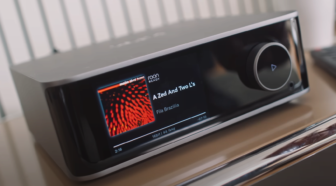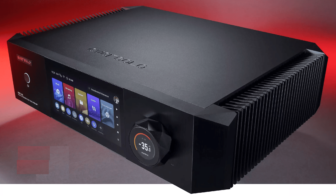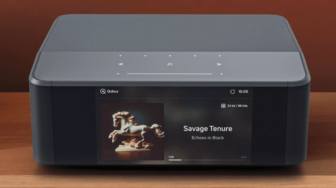BLUESOUND NODE 2i Review – Blue Funday
For audio streaming, BluOS offers its own software platform, supporting components from NAD, DALI, and Bluesound. With the Vault 2i server and the Bluesound Node 2i streamer, a compact multiroom system can be realized. Tested at 550 euros.

Junior sibling of Bluesound’s Powernode 2i
Sonos Connect; Yamaha WX-AD10
Specs
| CONNECTIONS | 3.5mm input; stereo phono analogue output; coaxial audio output; optical audio input/output; USB; 3.5mm headphone jack; subwoofer output; 12V trigger; Ethernet |
| SUPPORTED AUDIO FORMATS | FLAC, MQA, WAV and AIFF (hi-res); MP3, AAC, WMA, OGG, OPUS and ALAC |
| SUPPORTED SERVICES | Spotify, Amazon Music, TIDAL, Deezer, Qobuz, JUKE, Napster, Tuneln and more DIMENSIONS: 22 |
| DIMENSIONS | 220(w) x 46(h) x 146(d)mm |
| WEIGHT | 1.12kg |
| Website | bluesound.com |
Reinhard Paprotka
The two devices seem small and inconspicuous. However, they pack a lot of technology, making them quite understated. This is especially true for the Vault 2i, a music server/streamer with CD-ripping capability, offered by the Canadian manufacturer Bluesound for around 1300 euros. The Node 2i, a pure streamer, costs only 550 euros and works perfectly with the Vault 2i, even in multiple setups for multiroom operation.
Let’s start with the server. The heart of the Vault 2i is the built-in storage, which is a two-terabyte hard drive. This is enough for about 5000 hours of music in CD quality in FLAC or ALAC formats. In HiRes format 24/96 with FLAC, it still offers 1600 hours.
The hard drive is a Western Digital Red from the durable server series. It’s a 3.5-inch drive, and in a quiet room from three meters away, it’s still somewhat audible—though only when no music is playing. Even quiet sounds will easily mask the drive noise. The Vault 2i does not have a cooling fan. Neither the server nor the streamer has power switches; they run continuously—the Vault 2i with 11 watts, which drops to 8 watts when the HDD shuts down automatically without access. Then the server makes no noise, and the streamer is silent anyway.
Operation via BluOS
An IR remote control is not included, but 15 commands can be programmed. Control is better handled through apps that allow for integrated handling of all BluOS components. Please refer to our text box for more details.
The devices handle network connection independently if done via LAN cable. Just plug in the cable, and shortly after, both components will appear in the app. The user interface is almost identical for both, making setup with multiple streamers easy. Unlike the Vault 2i, the Node 2i is also equipped with Wi-Fi, requiring access setup.
Network communication does not use DLNA but the SMB protocol supported by PC and Mac. On the PC, the Vault 2i’s storage is set up as a network drive and filled with pre-ripped music via drag and drop. This requires some PC knowledge and is not facilitated by a manual.
For transfer to the server, the music must be stored on the computer or on USB hard drives connected to it. Direct transfer via USB to the server is not possible. We measured data transfer performance at 13 and 17 MB/s depending on the direction. The gigabit interface isn’t fully utilized, but large data transfers aren’t everyday occurrences. For playback, the data rate is only 2 MB/s even with PCM 24/192, ensuring that multiple rooms/Node 2i units can be supplied.
The simplest way to get music onto the server is CD ripping. Meta-information, including covers, is added during transfer from the PC, and integration into a music database occurs. This allows access at the directory level. However, the Vault 2i cannot be used as a CD player.
USB Direct Connection
With USB direct connection, both the server and the streamer can play local USB content. Each device can also connect to one analog or digital source, controlled via the BluOS app. Since this also includes volume and sound adjustments (both can be turned off), connecting active speakers is enough to set up a minimal-component system.
The Vault 2i has its own routine for data backup. This backup goes to USB storage in Linux format ext4. It’s advisable to back up valuable music data to another HDD in the ExFAT format accepted by PC and Mac, which is easily done via SMB. The Vault 2i uses a dual-core ARM Cortex processor with a 1-gigahertz clock frequency. It’s not enough to run a Roon Core, but the Vault 2i and Node 2i are Roon ready.
Both support Bluetooth with higher-quality aptX-HD coding. Music can be sent from the smartphone to the system and from the system to headphones, provided all devices support aptX-HD.
In terms of audio technology, the Vault 2i and Node 2i are identically built, as confirmed by measurements and listening tests. Formats supported include MQA but not DSD directly, with Bluesound specifying 192 kHz and 32-bit signal processing.
In our test setup, the network duo revealed a surprising ease in depth layering, brilliant highs, and stable mids, creating a great image. Despite high CD-rip quality, HiRes formats had the edge.
BluOS: A Comfortable and Reliable Streaming Platform
Vault 2i and Node 2i use established BluOS streaming software, which also integrates NAD and DALI products. Operation via apps for Android and iOS is quick and smooth, with no difference in the well-thought-out user interface between Vault, Node, and other BluOS components. The software creates a database, offers information on music formats, and accesses web information about artists, albums, and lyrics. In testing, BluOS proved stable and reliable. BluOS supports 17 music services, seamlessly combining their titles with playlists of locally stored music.
When you purchase through links on our site, I may earn an affiliate commission. Here’s how it works.









Great review! I’ve been considering the Bluesound Node 2i, and your insights on its sound quality and features really helped clarify my decision. It sounds like it offers excellent value for the price. Thanks for the detailed analysis!